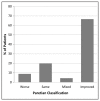Chiropractic integration within a community health centre: a cost description and partial analysis of cost-utility from the perspective of the institution
- PMID: 31564745
- PMCID: PMC6743653
Chiropractic integration within a community health centre: a cost description and partial analysis of cost-utility from the perspective of the institution
Abstract
Objective: To evaluate costs and consequences of a new back pain service provided by chiropractors integrated into a Community Health Centre in Cambridge, Ontario. The study sample included 95 consecutive patients presenting between January 2014 to January 2016 with a mixture of sub-acute and chronic back pain.
Methods: A secondary cost-utility analysis was performed and conducted from the perspective of the healthcare institution. Cost-utility was calculated as cost per quality-adjusted life year (QALY) gained over a time horizon of 90 days.
Results: According to the EuroQol 5 Domain questionnaire, nearly 70% of patients improved. The mean number of treatment sessions was 8.4, and an average of 0.21 QALYs were gained at an average cost per QALY of $1,042. Seventy-seven percent of patients did not visit their primary care provider over the 90-day period, representing potential cost savings to the institution of between $2,022.23 and $6,135.82.
Conclusion: Adding chiropractic care to usual medical care was associated with improved outcomes at a reasonable cost in a sample of complex patients with sub-acute and chronic back pain. Future comparative cost-effectiveness studies are needed.
Objectif: Évaluer les coûts et les conséquences d’un nouveau service pour soulager les maux de dos offert par des chiropraticiens intégrés à un centre de santé communautaire à Cambridge, en Ontario. L’échantillon de l’étude comprenait 95 patients qui se sont présentés consécutivement entre janvier 2014 et janvier 2016 et qui étaient atteints de diverses douleurs dorsales subaiguës et chroniques.
Méthodes: Une analyse coût-utilité secondaire a été effectuée du point de vue de l’établissement de santé. Le coût-utilité a été calculé en tant que coût par année de vie ajustée en fonction de la qualité (AVAQ) obtenu sur une période de 90 jours.
Résultats: Selon les résultats du questionnaire EuroQol 5 Domain, près de 70 % des patients ont observé une amélioration de leurs symptômes. Le nombre moyen de séances de traitement était de 8,4 et une moyenne de 0,21 AVAQ a été obtenue à un coût moyen par AVAQ de 1 042 $. Soixante-dix-sept pour cent des patients n’ont pas consulté leur fournisseur de soins primaires au cours de la période de 90 jours, ce qui représente des économies potentielles de l’ordre de 2 022,23 $ à 6 135,82 $ pour l’établissement.
Conclusion: L’ajout de soins chiropratiques aux soins médicaux habituels a entraîné une amélioration des résultats à un coût raisonnable pour un échantillon de patients ayant des besoins complexes et présentant des douleurs dorsales subaiguës et chroniques. De futures études comparatives coût-efficacité sont nécessaires.
Keywords: chiropractic; community health centres; cost analysis; health services research.
© JCCA 2019.
Conflict of interest statement
Disclaimer: PCE is supported by research grants from McMaster University and the NCMIC Foundation for graduate studies. The other authors have no disclaimers, competing interests, or sources of support or funding to report in the preparation of this manuscript.
Figures




References
-
- Bronfort G, Haas M, Evans RL, Bouter LM. Efficacy of spinal manipulation and mobilization for low back pain and neck pain: a systematic review and best evidence synthesis. Spine J. 2004;4(3):335–356. - PubMed
-
- Goertz CM, Long CR, Hondras MA, Petri R, Delgado R, Lawrence DJ, Owens EF, Meeker WC. Adding chiropractic manipulative therapy to standard medical care for patients with acute low back pain: results of a pragmatic randomized comparative effectiveness study. Spine. 2013;38(8):627–634. - PubMed
-
- Goertz CM, Long CR, Vining RD, Pohlman KA, Walter J, Coulter I. Effect of usual medical care plus chiropractic care vs usual medical care alone on pain and disability among US service members with low back pain: a comparative effectiveness clinical trial. JAMA Netw Open. 2018;1(1):e180105. - PMC - PubMed
LinkOut - more resources
Full Text Sources
